Four-Dimensional Printing for Hydrogel: Theoretical Concept, 4D Materials, Shape-Morphing Way, and Future Perspectives
Abstract
1. Introduction
2. Dimension (Scale) and Response Time of 4D-Printed Hydrogels
3. Comparative Analysis of 3D Hydrogel Printing, 4D Hydrogel Printing, and SMP-Based 4D Printing
4. Stimuli and Shape Transformation in 4D Printing for Hydrogel
5. Four Dimensional Dynamic and Shape-Morphing Way
5.1. One-Way Shape Morphing
5.2. Two-Way Shape Morphing
5.3. Multiway Shape Morphing
6. Shape-Memory Effect of Hydrogels
7. Classification of SMH-Based on Stimulus: Stimuli Responsive SMHs
7.1. Aqueous (Water)-Sensitive SMHs
7.2. Thermosensitive SMHs
7.3. Chemically Sensitive SMHs
7.4. Comparative Analysis of 3D- and 4D-Printing Techniques
7.5. Overcoming Rheological Limitations of 3D-/4D-Printing Hydrogels
8. Challenges and Future Perspective
Author Contributions
Funding
Institutional Review Board Statement
Informed Consent Statement
Data Availability Statement
Acknowledgments
Conflicts of Interest
References
- Tibbits, S. 4D printing: Multi-material shape change. Archit. Des. 2014, 84, 116–121. [Google Scholar] [CrossRef]
- Ashammakhi, N.; Ahadian, S.; Zengjie, F.; Suthiwanich, K.; Lorestani, F.; Orive, G.; Ostrovidov, S.; Khademhosseini, A. Advances and Future Perspectives in 4D Bioprinting. Biotechnol. J. 2018, 13, e1800148. [Google Scholar] [CrossRef]
- Lui, Y.S.; Sow, W.T.; Tan, L.P.; Wu, Y.; Lai, Y.; Li, H. 4D printing and stimuli-responsive materials in biomedical aspects. Acta Biomater. 2019, 92, 19–36. [Google Scholar] [CrossRef] [PubMed]
- Meng, H.; Li, G. A review of stimuli-responsive shape memory polymer composites. Polymer 2013, 54, 2199–2221. [Google Scholar] [CrossRef]
- Liu, X.; Zheng, Y.; Peurifoy, S.R.; Kothari, E.A.; Braunschweig, A.B. Optimization of 4D polymer printing within a massively parallel flow-through photochemical microreactor. Polym. Chem. 2016, 7, 3229–3235. [Google Scholar] [CrossRef]
- Ding, Z.; Yuan, C.; Peng, X.; Wang, T.; Qi, H.J.; Dunn, M.L. Direct 4D printing via active composite materials. Sci. Adv. 2017, 3, e1602890. [Google Scholar] [CrossRef] [PubMed]
- Kirillova, A.; Maxson, R.; Stoychev, G.; Gomillion, C.T.; Ionov, L. 4D Biofabrication Using Shape-Morphing Hydrogels. Adv. Mater. 2017, 29, 1703443. [Google Scholar] [CrossRef]
- Ge, Q.; Qi, H.J.; Dunn, M.L. Active materials by four-dimension printing. Appl. Phys. Lett. 2013, 103, 131901. [Google Scholar] [CrossRef]
- Brown, J.E.; Moreau, J.E.; Berman, A.M.; McSherry, H.J.; Coburn, J.M.; Schmidt, D.F.; Kaplan, D.L. Shape Memory Silk Protein Sponges for Minimally Invasive Tissue Regeneration. Adv. Healthc. Mater. 2016, 6, 1600762. [Google Scholar] [CrossRef]
- Löwenberg, C.; Balk, M.; Wischke, C.; Behl, M.; Lendlein, A. Shape-Memory Hydrogels: Evolution of Structural Principles To Enable Shape Switching of Hydrophilic Polymer Networks. Acc. Chem. Res. 2017, 50, 723–732. [Google Scholar] [CrossRef] [PubMed]
- Sepantafar, M.; Maheronnaghsh, R.; Mohammadi, H.; Radmanesh, F.; Hasani-sadrabadi, M.M.; Ebrahimi, M.; Baharvand, H. Engineered Hydrogels in Cancer Therapy and Diagnosis. Trends Biotechnol. 2017, 35, 1074–1087. [Google Scholar] [CrossRef] [PubMed]
- Purcell, B.P.; Lobb, D.; Charati, M.B.; Dorsey, S.M.; Wade, R.J.; Zellars, K.N.; Doviak, H.; Pettaway, S.; Logdon, C.B.; Shuman, J.A.; et al. Injectable and bioresponsive hydrogels for on-demand matrix metalloproteinase inhibition. Nat. Mater. 2014, 13, 653–661. [Google Scholar] [CrossRef] [PubMed]
- Mosiewicz, K.A.; Kolb, L.; Van Der Vlies, A.J.; Martino, M.M.; Lienemann, P.S.; Hubbell, J.A.; Ehrbar, M.; Lutolf, M.P. In situ cell manipulation through enzymatic hydrogel photopatterning. Nat. Mater. 2013, 12, 1072–1078. [Google Scholar] [CrossRef] [PubMed]
- Gladman, A.S.; Matsumoto, E.A.; Nuzzo, R.G.; Mahadevan, L.; Lewis, J.A. Biomimetic 4D printing. Nat. Mater. 2016, 15, 413–418. [Google Scholar] [CrossRef]
- Kim, Y.S.; Liu, M.; Ishida, Y.; Ebina, Y.; Osada, M.; Sasaki, T.; Hikima, T.; Takata, M.; Aida, T. Thermoresponsive actuation enabled by permittivity switching in an electrostatically anisotropic hydrogel. Nat. Mater. 2015, 14, 1002–1007. [Google Scholar] [CrossRef] [PubMed]
- Jeon, S.-J.; Hayward, R.C. Reconfigurable Microscale Frameworks from Concatenated Helices with Controlled Chirality. Adv. Mater. 2017, 29, 1606111. [Google Scholar] [CrossRef]
- Kawata, S.; Sun, H.-B.; Tanaka, T.; Takada, K. Finer features for functional microdevices. Nature 2001, 412, 697–698. [Google Scholar] [CrossRef] [PubMed]
- Kaehr, B.; Shear, J.B. Multiphoton fabrication of chemically responsive protein hydrogels for microactuation. Proc. Natl. Acad. Sci. USA 2008, 105, 8850–8854. [Google Scholar] [CrossRef]
- Raasch, J.; Ivey, M.; Aldrich, D.; Nobes, D.; Ayranci, C. Characterization of polyurethane shape memory polymer processed by material extrusion additive manufacturing. Addit. Manuf. 2015, 8, 132–141. [Google Scholar] [CrossRef]
- Osada, Y.; Matsuda, A. Shape memory in hydrogels. Nature 1995, 376, 219. [Google Scholar] [CrossRef] [PubMed]
- Yoshida, R.; Okano, T. Stimuli-Responsive Hydrogels and Their Application to Functional Materials. In Biomedical Applications of Hydrogels Handbook; Ottenbrite, R.M., Park, K., Okano, T., Eds.; Springer: New York, NY, USA, 2010; pp. 19–43. [Google Scholar]
- Nebhani, L.; Choudhary, V.; Adler, H.-J.; Kuckling, D. pH- and Metal Ion- Sensitive Hydrogels based on N-[2-(dimethylaminoethyl)-acrylamide]. Polymers 2016, 8, 233. [Google Scholar] [CrossRef] [PubMed]
- Julich-Gruner, K.K.; Löwenberg, C.; Neffe, A.T.; Behl, M.; Lendlein, A. Recent Trends in the Chemistry of Shape-Memory Polymers. Macromol. Chem. Phys. 2013, 214, 527–536. [Google Scholar] [CrossRef]
- Bellin, I.; Kelch, S.; Langer, R.; Lendlein, A. Polymeric tripleshape materials. Proc. Natl. Acad. Sci. USA 2006, 103, 18043–18047. [Google Scholar] [CrossRef] [PubMed]
- Xie, T. Tunable polymer multi-shape memory effect. Nature 2010, 464, 267–270. [Google Scholar] [CrossRef] [PubMed]
- Chung, T.; Romo-Uribe, A.; Mather, P.T. Two-Way Reversible Shape Memory in a Semicrystalline Network. Macromolecules 2008, 41, 184–192. [Google Scholar] [CrossRef]
- Du, H.; Zhang, J. Solvent induced shape recovery of shape memory polymer based on chemically cross-linked poly(vinyl alcohol). Soft Matter 2010, 6, 3370–3376. [Google Scholar] [CrossRef]
- Cabrera, M.S.; Sanders, B.; Goor, O.J.; Driessen-Mol, A.; Oomens, C.W.; Baaijens, F.P. Computationally designed 3D printed self-expandable polymer stents with biodegradation capacity for minimally invasive heart valve implantation: A proof-of-concept study. 3D Print. Addit. Manuf. 2017, 4, 19–29. [Google Scholar] [CrossRef] [PubMed]
- Senatov, F.S.; Niaza, K.V.; Zadorozhnyy, M.Y.; Maksimkin, A.V.; Kaloshkin, S.D.; Estrin, Y.Z. Mechanical properties and shape memory effect of 3D-printed PLA-based porous scaffolds. J. Mech. Behav. Biomed. Mater. 2016, 57, 139–148. [Google Scholar] [CrossRef] [PubMed]
- Miao, S.; Zhu, W.; Castro, N.J.; Nowicki, M.; Zhou, X.; Cui, H.; Fisher, J.P.; Zhang, L.G. 4D printing smart biomedical scaffolds with novel soybean oil epoxidized acrylate. Sci. Rep. 2016, 6, 27226. [Google Scholar] [CrossRef]
- Zhang, B.; Zhang, W.; Zhang, Z.; Zhang, Y.-F.; Hingorani, H.; Liu, Z.; Liu, J.; Ge, Q. Self-healing four-dimensional printing with an ultraviolet curable double-network shape memory polymer system. ACS Appl. Mater. Interfaces 2019, 11, 10328–10336. [Google Scholar] [CrossRef] [PubMed]
- Makvandi, P.; Ali, G.W.; Sala, F.D.; Abdel-Fattah, W.I.; Borzacchiello, A. Hyaluronic acid/corn silk extract based injectable nanocomposite: A biomimetic antibacterial scaffold for bone tissue regeneration. Mater. Sci. Eng. C 2020, 107, 110195–110205. [Google Scholar] [CrossRef]
- Leng, J.; Zhang, L.G. Four dimensional printing hierarchy scaffolds with highly biocompatible smart polymers for tissue engineering applications. Tissue Eng. Part C 2016, 22, 952–963. [Google Scholar]
- Zarek, M.; Mansour, N.; Shapira, S.; Cohn, D. 4D printing of shape memory-based personalized endoluminal medical devices. Macromol. Rapid Commun. 2017, 38, 1600628. [Google Scholar] [CrossRef]
- Martins, A.M.; Santos, M.I.; Azevedo, H.S.; Malafaya, P.B.; Reis, R.L. Natural origin scaffolds with in situ pore forming capability for bone tissue engineering applications. Acta Biomater. 2008, 4, 1637–1645. [Google Scholar] [CrossRef][Green Version]
- Ceylan, H.; Yasa, I.C.; Yasa, O.; Tabak, A.F.; Giltinan, J.; Sitti, M. 3D-Printed Biodegradable Microswimmer for Theranostic Cargo Delivery and Release. ACS Nano 2019, 13, 3353–3362. [Google Scholar] [CrossRef] [PubMed]
- Wei, H.; Zhang, Q.; Yao, Y.; Liu, L.; Liu, Y.; Leng, J. Direct-write fabrication of 4D active shape-changing structures based on a shape memory polymer and its nanocomposite. ACS Appl. Mater. Interfaces 2017, 9, 876–883. [Google Scholar] [CrossRef] [PubMed]
- Morrison, R.J.; Hollister, S.J.; Niedner, M.F.; Mahani, M.G.; Park, A.H.; Mehta, D.K.; Ohye, R.G.; Green, G.E. Mitigation of tracheobronchomalacia with 3D-printed personalized medical devices in pediatric patients. Sci. Transl. Med. 2015, 7, 285ra64. [Google Scholar] [CrossRef]
- Song, E.; da Costa, T.H.; Choi, J.W. A chemiresistive glucose sensor fabricated by inkjet printing. Microsyst. Technol. 2017, 23, 3505–3511. [Google Scholar] [CrossRef]
- Zhang, S.; Bellinger, A.M.; Glettig, D.L.; Barman, R.; Lee, Y.A.; Zhu, J.; Cleveland, C.; Montgomery, V.A.; Gu, L.; Nash, L.D.; et al. A pH-responsive supramolecular polymer gel as an enteric elastomer for use in gastric devices. Nat. Mater. 2015, 14, 1065–1071. [Google Scholar] [CrossRef] [PubMed]
- Lee, M.E.; Armani, A.M. Flexible UV exposure sensor based on UV responsive polymer. ACS Sens. 2016, 1, 1251–1255. [Google Scholar] [CrossRef]
- Lv, C.; Xia, H.; Shi, Q.; Wang, G.; Wang, Y.-S.; Chen, Q.-D.; Zhang, Y.-L.; Liu, L.-Q.; Sun, H.-B. Sensitively Humidity-Driven Actuator Based on Photopolymerizable PEG-DA Films. Adv. Mater. Interfaces 2017, 4, 1601002. [Google Scholar] [CrossRef]
- Mirani, B.; Pagan, E.; Currie, B.; Siddiqui, M.A.; Hosseinzadeh, R.; Mostafalu, P.; Zhang, Y.S.; Ghahary, A.; Akbari, M. An advanced multifunctional hydrogel-based dressing for wound monitoring and drug delivery. Adv. Healthc. Mater. 2017, 6, 1700718. [Google Scholar] [CrossRef]
- Pedron, S.; Van Lierop, S.; Horstman, P.; Penterman, R.; Broer, D.; Peeters, E. Stimuli responsive delivery vehicles for cardiac micro tissue transplantation. Adv. Funct. Mater. 2011, 21, 1624–1630. [Google Scholar] [CrossRef]
- Ma, M.; Guo, L.; Anderson, D.G.; Langer, R. Bio-Inspired Polymer Composite Actuator and Generator Driven by Water Gradients. Science 2013, 339, 186–189. [Google Scholar] [CrossRef] [PubMed]
- Zhang, L.; Liang, H.; Jacob, J.; Naumov, P. Photogated humidity-driven motility. Nat. Commun. 2015, 6. [Google Scholar] [CrossRef] [PubMed]
- Therien-Aubin, H.; Wu, Z.L.; Nie, Z.; Kumacheva, E. Multiple shape transformations of composite hydrogel sheets. J. Am. Chem. Soc. 2013, 135, 4834–4839. [Google Scholar] [CrossRef] [PubMed]
- Malachowski, K.; Breger, J.; Kwag, H.R.; Wang, M.O.; Fisher, J.P.; Selaru, F.M.; Gracias, D.H. Stimuli-responsive theragrippers for chemomechanical controlled release. Angew. Chem. Int. Ed. 2014, 53, 8045–8049. [Google Scholar] [CrossRef] [PubMed]
- Zhang, Y.; Ionov, L. Reversibly Cross-Linkable Thermoresponsive Self-Folding Hydrogel Films. Langmuir 2015, 31, 4552–4557. [Google Scholar] [CrossRef]
- Wu, Z.L.; Moshe, M.; Greener, J.; Thérien-Aubin, H.; Nie, Z.H.; Sharon, E.; Kumacheva, E. Three-dimensional shape transformations of hydrogel sheets induced by small-scale modulation of internal stresses. Nat. Commun. 2013, 4, 1586. [Google Scholar]
- Zhao, J.; Fang, C.; Zhu, Y.; He, G.; Pan, F.; Jiang, Z.; Zhang, P.; Cao, X.; Wang, B. Manipulating the interfacial interactions of composite membranes via a mussel-inspired approach for enhanced separation selectivity. J. Mater. Chem. A 2015, 3, 19980–19988. [Google Scholar] [CrossRef]
- Guo, W.; Lu, C.-H.; Orbach, R.; Wang, F.; Qi, X.-J.; Cecconello, A.; Seliktar, D.; Willner, I. pH-Stimulated DNA Hydrogels Exhibiting Shape-Memory Properties. Adv. Mater. 2015, 27, 73–78. [Google Scholar] [CrossRef] [PubMed]
- Kahn, J.S.; Hu, Y.; Willner, I. Stimuli-Responsive DNA-Based Hydrogels: From Basic Principles to Applications. Acc. Chem. Res. 2017, 50, 680–690. [Google Scholar] [CrossRef] [PubMed]
- Uchida, M.; Kurosawa, M.; Osada, Y. Swelling Process and Order-Disorder Transition of Hydrogel Containing Hydrophobic Ionizable Groups. Macromolecules 1995, 28, 4583–4586. [Google Scholar] [CrossRef]
- Mitsumata, T.; Gong, J.P.; Osada, Y. Shape memory functions and motility of amphiphilic polymer gels. Polym. Adv. Technol. 2001, 12, 136–150. [Google Scholar] [CrossRef]
- Balk, M.; Behl, M.; Nöchel, U.; Lendlein, A. Shape-Memory Hydrogels with Switching Segments Based on Oligo(ω-pentadecalactone). Macromol. Mater. Eng. 2012, 297, 1184–1192. [Google Scholar] [CrossRef]
- Li, G.; Zhang, H.J.; Fortin, D.; Xia, H.S.; Zhao, Y. Poly(vinyl alcohol)-Poly(ethylene glycol) Double-Network Hydrogel: A General Approach to Shape Memory and Self-Healing Functionalities. Langmuir 2015, 31, 11709–11716. [Google Scholar] [CrossRef] [PubMed]
- Ren, Z.Q.; Zhang, Y.Y.; Li, Y.M.; Xu, B.; Liu, W.G. Hydrogen bonded and ionically crosslinked high strength hydrogels exhibiting Ca2+- triggered shape memory properties and volume shrinkage for cell detachment. J. Mater. Chem. B 2015, 3, 6347–6354. [Google Scholar] [CrossRef]
- Li, G.; Yan, Q.; Xia, H.; Zhao, Y. Therapeutic-Ultrasound-Triggered Shape Memory of a Melamine-Enhanced Poly(vinyl alcohol) Physical Hydrogel. ACS Appl. Mater. Interfaces 2015, 7, 12067–12073. [Google Scholar] [CrossRef] [PubMed]
- Fan, Y.J.; Zhou, W.F.; Yasin, A.; Li, H.Z.; Yang, H.Y. Dualresponsive shape memory hydrogels with novel thermoplasticity based on a hydrophobically modified polyampholyte. Soft Matter 2015, 11, 4218–4225. [Google Scholar] [CrossRef]
- Nöchel, U.; Behl, M.; Balk, M.; Lendlein, A. Thermally-Induced Triple-Shape Hydrogels: Soft Materials Enabling Complex Movements. ACS Appl. Mater. Interfaces 2016, 8, 28068–28076. [Google Scholar] [CrossRef] [PubMed]
- Han, Y.; Bai, T.; Liu, Y.; Zhai, X.; Liu, W. Zinc ion uniquely induced triple shape memory effect of dipole-dipole reinforced ultrahigh strength hydrogels. Macromol. Rapid Commun. 2012, 33, 225–231. [Google Scholar] [CrossRef] [PubMed]
- Xiao, Y.-Y.; Gong, X.-L.; Kang, Y.; Jiang, Z.-C.; Zhang, S.; Li, B.-J. Light-, pH- and thermal-responsive hydrogels with the triple-shape memory effect. Chem. Commun. 2016, 52, 10609–10612. [Google Scholar] [CrossRef] [PubMed]
- Skrzeszewska, P.J.; Jong, L.N.; de Wolf, F.A.; Cohen Stuart, M.A.; van der Gucht, J. Shape-Memory Effects in Biopolymer Networks with Collagen-Like Transient Nodes. Biomacromolecules 2011, 12, 2285–2292. [Google Scholar] [CrossRef] [PubMed]
- Huang, J.H.; Zhao, L.; Wang, T.; Sun, W.X.; Tong, Z. NIR-Triggered Rapid Shape Memory PAM-GO-Gelatin Hydrogels with High Mechanical Strength. ACS Appl. Mater. Interfaces 2016, 8, 12384–12392. [Google Scholar] [CrossRef]
- Izawa, H.; Kadokawa, J.-I. Preparation and characterizations of functional ionic liquid-gel and hydrogel materials of xanthan gum. J. Mater. Chem. 2010, 20, 5235–5241. [Google Scholar] [CrossRef]
- Li, Z.W.; Lu, W.; Ngai, T.; Le, X.X.; Zheng, J.; Zhao, N.; Huang, Y.J.; Wen, X.F.; Zhang, J.W.; Chen, T. Mussel-inspired multifunctional supramolecular hydrogels with self-healing, shape memory and adhesive properties. Polym. Chem. 2016, 7, 5343–5346. [Google Scholar] [CrossRef]
- Meng, H.; Zheng, J.; Wen, X.F.; Cai, Z.Q.; Zhang, J.W.; Chen, T. pH- and Sugar-Induced Shape Memory Hydrogel Based on Reversible Phenylboronic Acid-Diol Ester Bonds. Macromol. Rapid Commun. 2015, 36, 533–537. [Google Scholar] [CrossRef]
- Le, X.; Lu, W.; Zheng, J.; Tong, D.; Zhao, N.; Ma, C.; Xiao, H.; Zhang, J.; Huang, Y.; Chen, T. Stretchable supramolecular hydrogels with triple shape memory effect. Chem. Sci. 2016, 7, 6715–6720. [Google Scholar] [CrossRef]
- Balk, M.; Behl, M.; Nöchel, U.; Lendlein, A. Architectured Shape-Memory Hydrogels with Switching Segments Based on Oligo(ε-caprolactone). MRS Adv. 2016, 1, 2011–2017. [Google Scholar] [CrossRef][Green Version]
- Neffe, A.T.; Pierce, B.F.; Tronci, G.; Ma, N.; Pittermann, E.; Gebauer, T.; Frank, O.; Schossig, M.; Xu, X.; Willie, B.M.; et al. Hydrogels: One Step Creation of Multifunctional 3D Architectured Hydrogels Inducing Bone Regeneration. Adv. Mater. 2015, 27, 1738–1744. [Google Scholar] [CrossRef] [PubMed]
- Luo, R.; Wu, J.; Dinh, N.-D.; Chen, C.-H. Gradient Porous Elastic Hydrogels with Shape-Memory Property and Anisotropic Responses for Programmable Locomotion. Adv. Funct. Mater. 2015, 25, 7272–7279. [Google Scholar] [CrossRef]
- Zhang, P.; Behl, M.; Peng, X.; Razzaq, M.Y.; Lendlein, A. Ultrasonic Cavitation Induced Shape-Memory Effect in Porous Polymer Networks. Macromol. Rapid Commun. 2016, 37, 1849–1977. [Google Scholar] [CrossRef][Green Version]
- Xu, B.; Li, H.; Wang, Y.; Zhang, G.; Zhang, Q. Nanocomposite hydrogels with high strength cross-linked by titania. RSC Adv. 2013, 3, 7233–7236. [Google Scholar] [CrossRef]
- Brenken, B.; Barocio, E.; Favaloro, A.; Kunc, V.; Pipes, R.B. Fused filament fabrication of fiber-reinforced polymers: A review. Addit. Manuf. 2018, 21, 1–16. [Google Scholar] [CrossRef]
- Highley, C.B.; Rodell, C.B.; Burdick, J.A. Direct 3D Printing of Shear-Thinning Hydrogels into Self-Healing Hydrogels. Adv. Mater. 2015, 27, 5075–5079. [Google Scholar] [CrossRef] [PubMed]
- Kotikian, A.; Truby, R.L.; Boley, J.W.; White, T.J.; Lewis, J.A. 3D Printing of Liquid Crystal Elastomeric Actuators with Spatially Programed Nematic Order. Adv. Mater. 2018, 30, 1706164. [Google Scholar] [CrossRef]
- Ligon, S.C.; Liska, R.; Stampfl, J.; Gurr, M.; Mülhaupt, R. Polymers for 3D Printing and Customized Additive Manufacturing. Chem. Rev. 2017, 117, 10212–10290. [Google Scholar] [CrossRef]
- Yuan, C.; Kowsari, K.; Panjwani, S.; Chen, Z.; Wang, D.; Zhang, B.; Ng, C.J.-X.; Alvarado, P.V.Y.; Ge, Q. Ultrafast Three-Dimensional Printing of Optically Smooth Microlens Arrays by Oscillation-Assisted Digital Light Processing. ACS Appl. Mater. Interfaces 2019, 11, 40662–40668. [Google Scholar] [CrossRef] [PubMed]
- Yap, C.Y.; Chua, C.K.; Dong, Z.L.; Liu, Z.H.; Zhang, D.Q.; Loh, L.E.; Sing, S.L. Review of selective laser melting: Materials and applications. Appl. Phys. Rev. 2015, 2, 041101. [Google Scholar] [CrossRef]
- Terrani, K.; Jolly, B.; Trammell, M. 3D printing of high-purity silicon carbide. J. Am. Ceram. Soc. 2020, 103, 1575–1581. [Google Scholar] [CrossRef]
- Luong, D.X.; Subramanian, A.K.; Silva, G.A.L.; Yoon, J.; Cofer, S.; Yang, K.; Owuor, P.S.; Wang, T.; Wang, Z.; Lou, J.; et al. Laminated Object Manufacturing of 3D-Printed Laser-Induced Graphene Foams. Adv. Mater. 2018, 30, 1707416. [Google Scholar] [CrossRef] [PubMed]
- Li, G.W.; Zhao, J.; Fuh, J.Y.H.; Wu, W.Z.; Jiang, J.L.; Wanq, T.Q.; Chang, S. Experiments on the ultrasonic bonding additive manufacturing of metallic glass and crystalline metal composite. Materials 2019, 12, 2975. [Google Scholar] [CrossRef]
- Liu, Y.J.; Wang, H.L.; Li, S.J.; Wang, S.G.; Wang, W.J.; Hou, W.T.; Hao, Y.L.; Yang, R.; Zhang, L.C. Compressive and fatigue behavior of beta-type titanium porous structures fabricated by electron beam melting. Acta Mater. 2017, 126, 58–66. [Google Scholar] [CrossRef]
- Zhang, L.-C.; Liu, Y.; Li, S.; Hao, Y. Additive Manufacturing of Titanium Alloys by Electron Beam Melting: A Review. Adv. Eng. Mater. 2017, 20, 1700842. [Google Scholar] [CrossRef]
- Cao, J.; Zhou, C.; Su, G.; Zhang, X.; Zhou, T.; Zhou, Z.; Yang, Y. Arbitrarily 3D Configurable Hygroscopic Robots with a Covalent–Noncovalent Interpenetrating Network and Self-Healing Ability. Adv. Mater. 2019, 31, 1900042. [Google Scholar] [CrossRef]
- Mulakkal, M.C.; Trask, R.S.; Ting, V.P.; Seddon, A.M. Responsive cellulose-hydrogel composite ink for 4D printing. Mater. Des. 2018, 160, 108–118. [Google Scholar] [CrossRef]
- Aharoni, H.; Sharon, E.; Kupferman, R. Geometry of thin nematic elastomer sheets. Phys. Rev. Lett. 2014, 113, 257801. [Google Scholar] [CrossRef]
- Ji, Z.; Yan, C.; Yu, B.; Zhang, X.; Cai, M.; Jia, X.; Wang, X.; Zhou, F. 3D Printing of Hydrogel Architectures with Complex and Controllable Shape Deformation. Adv. Mater. Technol. 2019, 4, 1800713. [Google Scholar] [CrossRef]
- Wu, C.; Wang, X. Globule-to-Coil Transition of a Single Homopolymer Chain in Solution. Phys. Rev. Lett. 1998, 80, 4092–4094. [Google Scholar] [CrossRef]
- Halperin, A.; Kröger, M.; Winnik, F.M. Poly(N-isopropylacrylamide) Phase Diagrams: Fifty Years of Research. Angew. Chem. Int. Ed. 2015, 54, 15342–15367. [Google Scholar] [CrossRef]
- Bakarich, S.E.; Gorkin, R.; Panhuis, M.I.H.; Spinks, G.M. 4D Printing with Mechanically Robust, Thermally Actuating Hydrogels. Macromol. Rapid Commun. 2015, 36, 1211–1217. [Google Scholar] [CrossRef]
- Naficy, S.; Gately, R.; Gorkin, R.; Xin, H.; Spinks, G.M. 4D Printing of Reversible Shape Morphing Hydrogel Structures. Macromol. Mater. Eng. 2016, 302, 1600212. [Google Scholar] [CrossRef]
- Guo, J.; Zhang, R.; Zhang, L.; Cao, X. 4D Printing of Robust Hydrogels Consisted of Agarose Nanofibers and Polyacrylamide. ACS Macro Lett. 2018, 7, 442–446. [Google Scholar] [CrossRef]
- Hu, Y.; Wang, Z.; Jin, D.; Zhang, C.; Sun, R.; Li, Z.; Hu, K.; Ni, J.; Cai, Z.; Pan, D.; et al. 4D Printing: Botanical-Inspired 4D Printing of Hydrogel at the Microscale. Adv. Funct. Mater. 2020, 30, 1907377. [Google Scholar] [CrossRef]
- Larush, L.; Kaner, I.; Fluksman, A.; Tamsut, A.; Pawar, A.A.; Lesnovski, P.; Benny, O.; Magdassi, S. 3D printing of responsive hydrogels for drug-delivery systems. J. 3D Print. Med. 2017, 1, 219–229. [Google Scholar] [CrossRef]
- McCracken, J.M.; Rauzan, B.M.; Kjellman, J.C.E.; Su, H.; Rogers, S.A.; Nuzzo, R.G. Ionic Hydrogels with Biomimetic 4D-Printed Mechanical Gradients: Models for Soft-Bodied Aquatic Organisms. Adv. Funct. Mater. 2019, 29, 1806723. [Google Scholar] [CrossRef]
- Lee, J.H.; Han, W.J.; Jang, H.S.; Choi, H.J. Highly tough, biocompatible, and magneto-responsive Fe3O4/Laponite/PDMAAm nanocomposite hydrogels. Sci. Rep. 2019, 9. [Google Scholar] [CrossRef]
- Luo, Y.; Lin, X.; Chen, B.; Wei, X. Cell-laden 4D bioprinting using NIR-triggered shape morphing alginate/polydopamine bioinks. Biofabrication 2019, 11, 045019. [Google Scholar] [CrossRef] [PubMed]
- Dai, W.; Guo, H.; Gao, B.; Ruan, M.; Xu, L.; Wu, J.; Kirk, T.B.; Xu, J.; Ma, D.; Xue, W. Double network shape memory hydrogels activated by near-infrared with high mechanical toughness, nontoxicity, and 3D printability. Chem. Eng. J. 2019, 356, 934–949. [Google Scholar] [CrossRef]
- Ma, C.; Lu, W.; Yang, X.; He, J.; Le, X.; Wang, L.; Zhang, J.; Serpe, M.J.; Huang, Y.; Chen, T. Bioinspired anisotropic hydrogel actuators with on-off switchable and color-tunable fluorescence behaviors. Adv. Funct. Mater. 2017, 28, 1704568. [Google Scholar] [CrossRef]
- Gao, Y.; Xu, S.; Wu, R.; Wang, J.; Wei, J. Preparation and characteristic of electric stimuli responsive hydrogel composed of polyvinyl alcohol/poly (sodium maleate-co-sodium acrylate). J. Appl. Polym. Sci. 2008, 107, 391. [Google Scholar] [CrossRef]
- Hua, L.; Xie, M.; Jian, Y.; Wu, B.; Chen, C.; Zhao, C. Multiple-responsive and amphibious hydrogel actuator based on asymmetric UCST-type volume phase transition. ACS Appl. Mater. Interfaces 2019, 11, 43641–43648. [Google Scholar] [CrossRef]
- Boydston, A.J.; Cao, B.; Nelson, A.; Ono, R.J.; Saha, A.; Schwartz, J.J.; Thrasher, C.J. Additive manufacturing with stimuli-responsive materials. J. Mater. Chem. A 2018, 6, 20621–20645. [Google Scholar] [CrossRef]
- Liang, Z.; Liu, Y.; Zhang, F.; Ai, Y.; Liang, Q. Dehydration-triggered shape morphing based on asymmetric bubble hydrogel microfibers. Soft Matter 2018, 14, 6623–6626. [Google Scholar] [CrossRef] [PubMed]
- Qiao, Y.; Ma, W.; Theyssen, N.; Chen, C.; Hou, Z. Temperature-Responsive Ionic Liquids: Fundamental Behaviors and Catalytic Applications. Chem. Rev. 2017, 117, 6881–6928. [Google Scholar] [CrossRef]
- Seuring, J.; Agarwal, S. Polymers with Upper Critical Solution Temperature in Aqueous Solution. Macromol. Rapid Commun. 2012, 33, 1898–1920. [Google Scholar] [CrossRef]
- Han, X.-J.; Dong, Z.-Q.; Fan, M.-M.; Liu, Y.; Li, J.-H.; Wang, Y.-F.; Yuan, Q.-J.; Li, B.-J.; Zhang, S. pH-Induced Shape-Memory Polymers. Macromol. Rapid Commun. 2012, 33, 1055–1060. [Google Scholar] [CrossRef]
- Rastogi, P.; Kandasubramanian, B. Review on alginate-based hydrogel bio-printing for application in tissue engineering. Biofabrication 2019, 11, 042001. [Google Scholar] [CrossRef]
- Dong, Y.; Wang, S.; Ke, Y.; Ding, L.; Zeng, X.; Magdassi, S.; Long, Y. 4D Printed Hydrogels: Fabrication, Materials, and Applications. Adv. Mater. Technol. 2020, 5, 2000034. [Google Scholar] [CrossRef]
- Zhou, W.; Qiao, Z.; Zare, E.N.; Huang, J.; Zheng, X.; Sun, X.; Shao, M.; Wang, H.; Wang, X.; Chen, D.; et al. 4 D-Printed Dynamic Materials in Biomedical Applications: Chemistry, Challenges, and Their Future Perspectives in the Clinical Sector. J. Med. Chem. 2020, 63, 8003–8024. [Google Scholar] [CrossRef]
- Quanjin, M.; Rejab, M.R.M.; Idris, M.S.; Kumar, N.M.; Abdullah, M.H.; Reddy, G.R. Recent 3D and 4D intelligent printing technologies: A comparative review and future perspective. Procedia Comput. Sci. 2020, 167, 1210–1219. [Google Scholar] [CrossRef]
- Choi, J.; Kwon, O.-C.; Jo, W.; Lee, H.J.; Moon, M.-W. 4D Printing Technology: A Review. 3D Print. Addit. Manuf. 2015, 2, 159–167. [Google Scholar] [CrossRef]
- Cooke, M.E.; Rosenzweig, D.H. The rheology of direct and suspended extrusion bioprinting. APL Bioeng. 2021, 5, 011502. [Google Scholar] [CrossRef] [PubMed]
- Groll, J.; Burdick, J.A.; Cho, D.W.; Derby, B.; Gelinsky, M.; Heilshorn, S.C.; Juengst, T.; Malda, J.; Mironov, V.A.; Nakayama, K.; et al. A definition of bioinks and their distinction from biomaterial inks. Biofabrication 2018, 11, 013001. [Google Scholar] [CrossRef] [PubMed]
- Han, W.T.; Jang, T.; Chen, S.; Chong, L.S.H.; Jung, H.D.; Song, J. Improved cell viability for large-scale biofabrication with photo-crosslinkable hydrogel systems through a dual-photoinitiator approach. Biomater. Sci. 2020, 8, 450–461. [Google Scholar] [CrossRef] [PubMed]
- Gong, J.; Schuurmans, C.C.; van Genderen, A.M.; Cao, X.; Li, W.; Cheng, F.; He, J.J.; Lopez, A.; Huerta, V.; Manrıquez, J.; et al. Complexation-induced resolution enhancement of 3D-printed hydrogel constructs. Nat. Commun. 2020, 11, 1267. [Google Scholar] [CrossRef] [PubMed]
- Lorson, T.; Jaksch, S.; Lubtow, M.M.; Jungst, T.; Groll, J.; Luhmann, T.; Luxenhofer, R. A thermogelling supramolecular hydrogel with sponge-like morphology as a cytocompatible bioink. Biomacromolecules 2017, 18, 2161–2171. [Google Scholar] [CrossRef]
- Loebel, C.; Rodell, C.B.; Chen, M.H.; Burdick, J.A. Shear-thinning and self-healing hydrogels as injectable therapeutics and for 3D-printing. Nat. Protoc. 2017, 12, 1521–1541. [Google Scholar] [CrossRef]
- Hedegaard, C.L.; Collin, E.C.; Redondo-Gomez, C.; Nguyen, L.T.; Ng, K.W.; Castrejon-Pita, A.A.; Castrejon-Pita, J.R.; Mata, A. Hydrodynamically guided hierarchical self-assembly of peptide-protein bioinks. Adv. Funct. Mater. 2018, 28, 170371. [Google Scholar] [CrossRef]
- Lee, M.; Bae, K.; Levinson, C.; Zenobi-Wong, M. Nanocomposite bioink exploits dynamic covalent bonds between nanoparticles and polysaccharides for precision bioprinting. Biofabrication 2020, 12, 025025. [Google Scholar] [CrossRef]
- Ahlfeld, T.; Cidonio, G.; Kilian, D.; Duin, S.; Akkineni, A.R.; Dawson, J.I.; Yang, S.; Lode, A.; Oreffo, R.O.; Gelinsky, M. Development of a clay based bioink for 3D cell printing for skeletal application. Biofabrication 2017, 9, 034103. [Google Scholar] [CrossRef]
- Ouyang, L.; Armstrong, J.; Lin, Y.; Wojciechowski, J.; Lee-Reeves, C.; Hachin, D.; Zhou, K.; Burdick, J.A.; Stevens, M. Expanding and optimizing 3D bioprinting capabilities using complementary network bioinks. Sci. Adv. 2020, 6, 1–14. [Google Scholar] [CrossRef] [PubMed]
- Chiu, D.T.; de Mello, A.J.; Di Carlo, D.; Doyle, P.S.; Hansen, C.; Maceiczyk, R.M.; Wootton, R.C.R. Small but perfectly formed? successes, challenges, and opportunities for microfluidics in the chemical and biological sciences. Chem 2017, 2, 201–223. [Google Scholar] [CrossRef]
- Gao, B.; Yang, Q.; Zhao, X.; Jin, G.; Ma, Y.; Xu, F. 4D bioprinting for biomedical applications. Trends Biotechnol. 2016, 34, 746–756. [Google Scholar] [CrossRef] [PubMed]
- Zolfagharian, A.; Gregory, T.M.; Bodaghi, M.; Gharaie, S.; Fay, P. Patient-specific 3D-printed Splint for Mallet Finger Injury. Int. J. Bioprint. 2020, 6, 259. [Google Scholar] [CrossRef] [PubMed]
- Zolfagharian, A.; Denk, M.; Bodaghi, M.; Kouzani, A.Z.; Kaynak, A. Topology-Optimized 4D Printing of a Soft Actuator. Acta Mech. Solida Sin. 2019, 33, 418–430. [Google Scholar] [CrossRef]
- Yang, R.; Chen, C. Stress-based topology optimization. J. Struct. Optim. 1996, 12, 98–105. [Google Scholar] [CrossRef]
- Afagharian, A.; Kaynak, A.; Bodaghi, M.; Kouzani, A.Z.; Gharaie, S.; Nahavandi, S. Control-Based 4D Printing: Adaptive 4D-Printed Systems. Appl. Sci. 2020, 10, 3020. [Google Scholar] [CrossRef]
- Bodaghi, M.; Damanpack, A.R.; Liao, W.H. Adaptive metamaterials by functionally graded 4D printing. Mater. Des. 2017, 135, 26–36. [Google Scholar] [CrossRef]
- Zhu, C.; Liu, T.; Qian, F.; Chen, W.; Chandrasekaran, S.; Yao, B.; Song, Y.; Duoss, E.B.; Kuntz, J.B.; Spadaccini, C.M.; et al. 3D printed functional nanomaterials for electrochemical energy storage. Nano Today 2017, 15, 107–120. [Google Scholar] [CrossRef]
- Zeng, M.; Zhang, Y. Colloidal nanoparticle inks for printing functional devices: Emerging trends and future prospects. J. Mater. Chem. A 2019, 7, 23301–23336. [Google Scholar] [CrossRef]
- Li, Y.; Zhang, Z.; Su, M.; Huang, Z.; Li, Z.; Li, F.; Pan, Q.; Ren, W.; Hu, X.; Li, L.; et al. A general strategy for printing colloidal nanomaterials into one-dimension micro/nanolines. Nanoscale 2018, 10, 22374–22380. [Google Scholar] [CrossRef] [PubMed]
- Choi, Y.; Kim, C.; Kim, H.S.; Moon, C.; Lee, K.Y. 3D Printing of dynamic tissue scaffold by combining self-healing hydrogel and self-healing ferrogel. Colloids Surf. B Biointerfaces 2021, 208, 112108. [Google Scholar] [CrossRef] [PubMed]
- Zeng, M.; Kuang, W.; Khan, I.; Huang, D.; Du, Y.; Saeidi-Javash, M.; Zhang, L.; Cheng, Z.; Hoffman, A.J.; Zhang, Y. Colloidal Nanosurfactants for 3D Conformal Printing of 2D van der Waals Materials. Adv. Mater. 2020, 32, 2003081. [Google Scholar] [CrossRef] [PubMed]
- Saeidi-Javash, M.; Du, Y.; Zeng, M.; Wyatt, B.C.; Zhang, B.; Kempf, N.; Anasori, B.; Zhang, Y. All-Printed MXene-Graphene Nanosheet-Based Bimodal Sensors for Simultaneous Strain and Temperature Sensing. ACS Appl. Electron. Mater. 2021, 3, 2341–2348. [Google Scholar] [CrossRef]
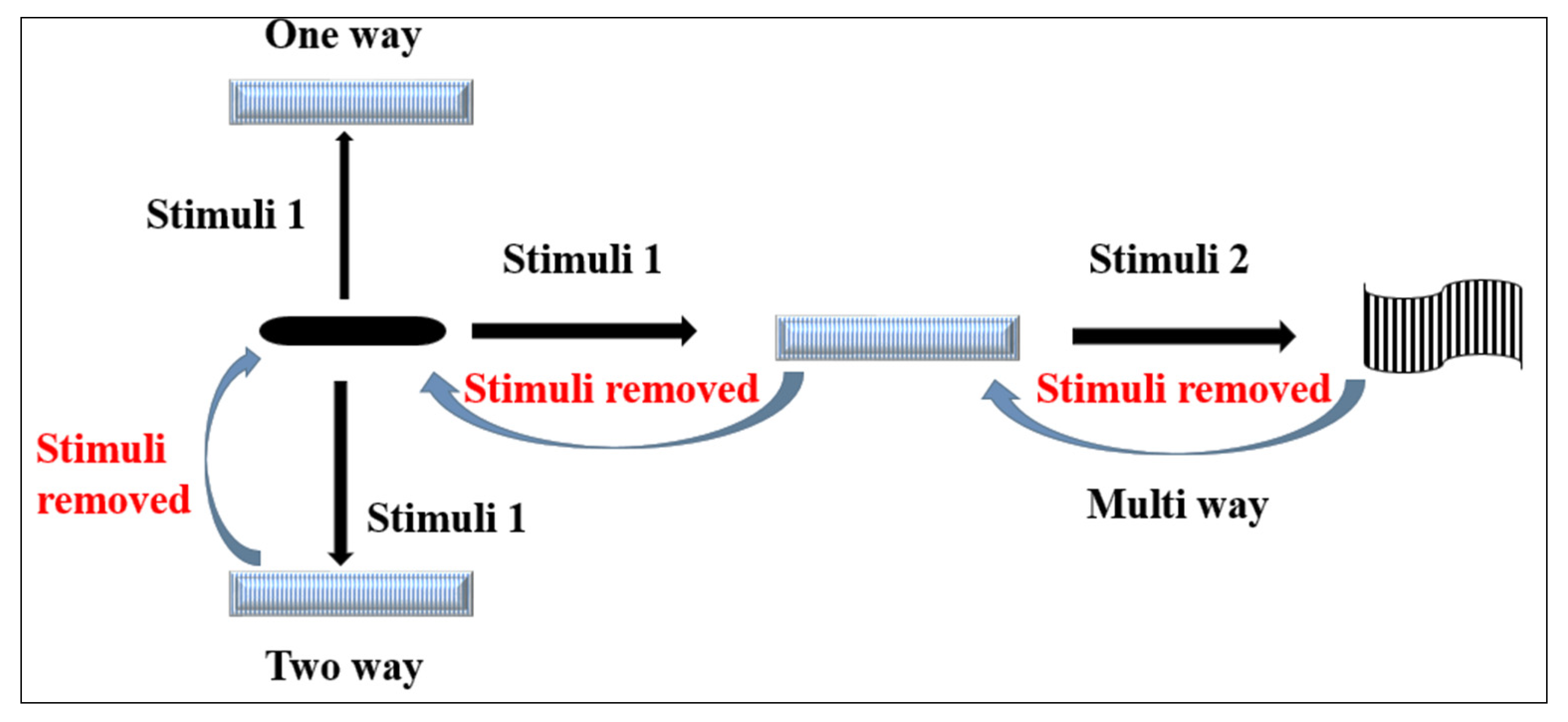
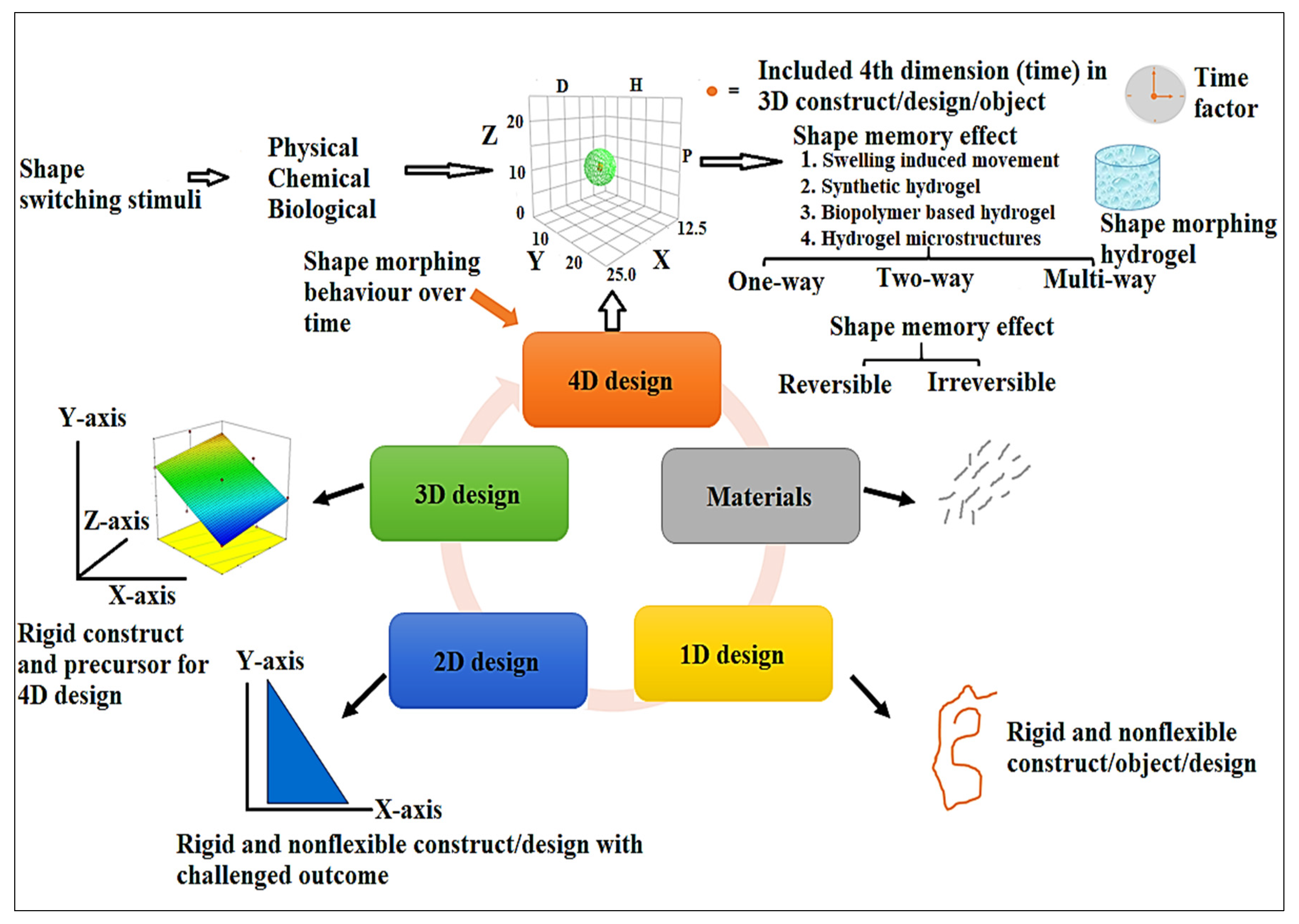
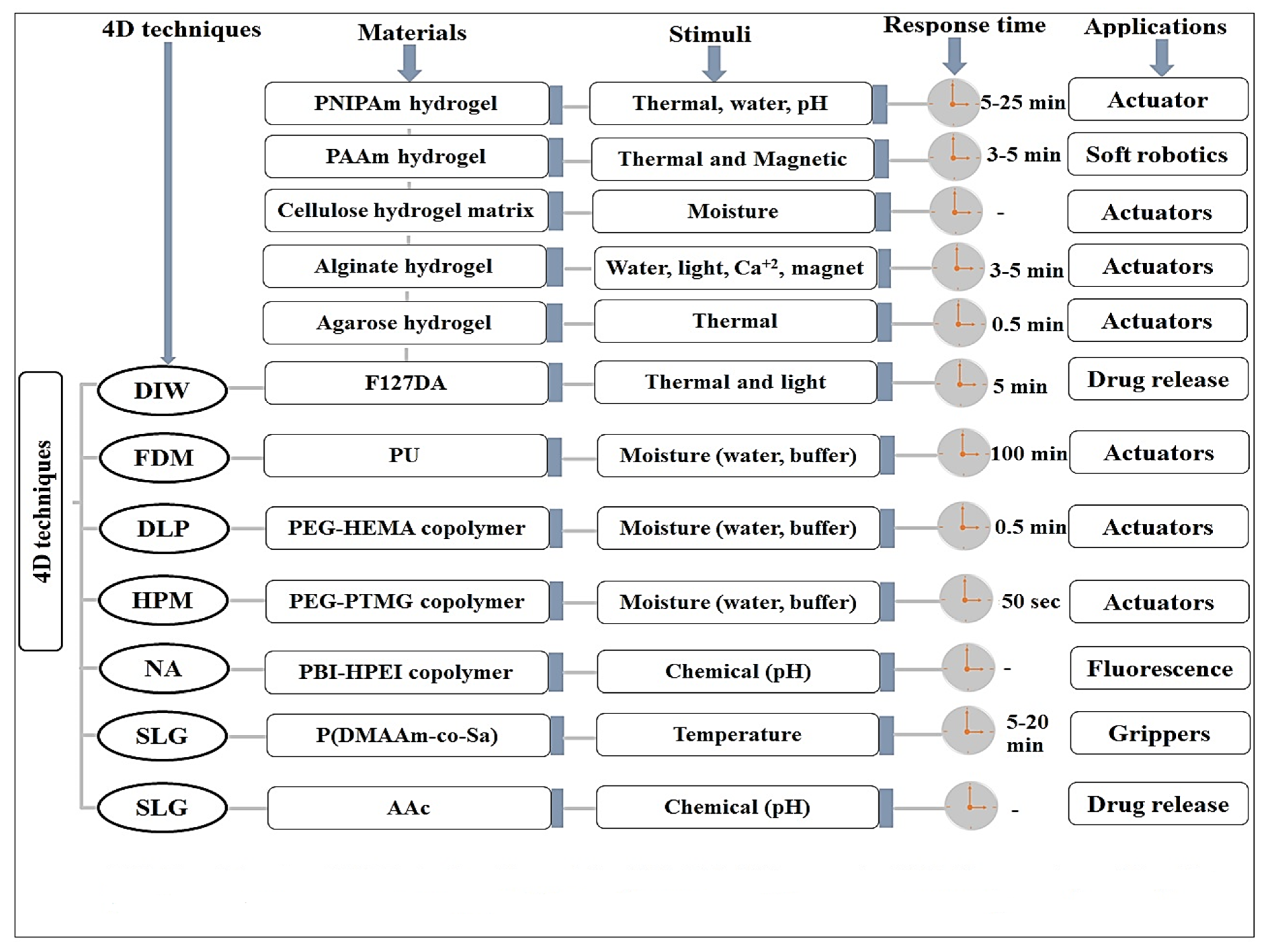
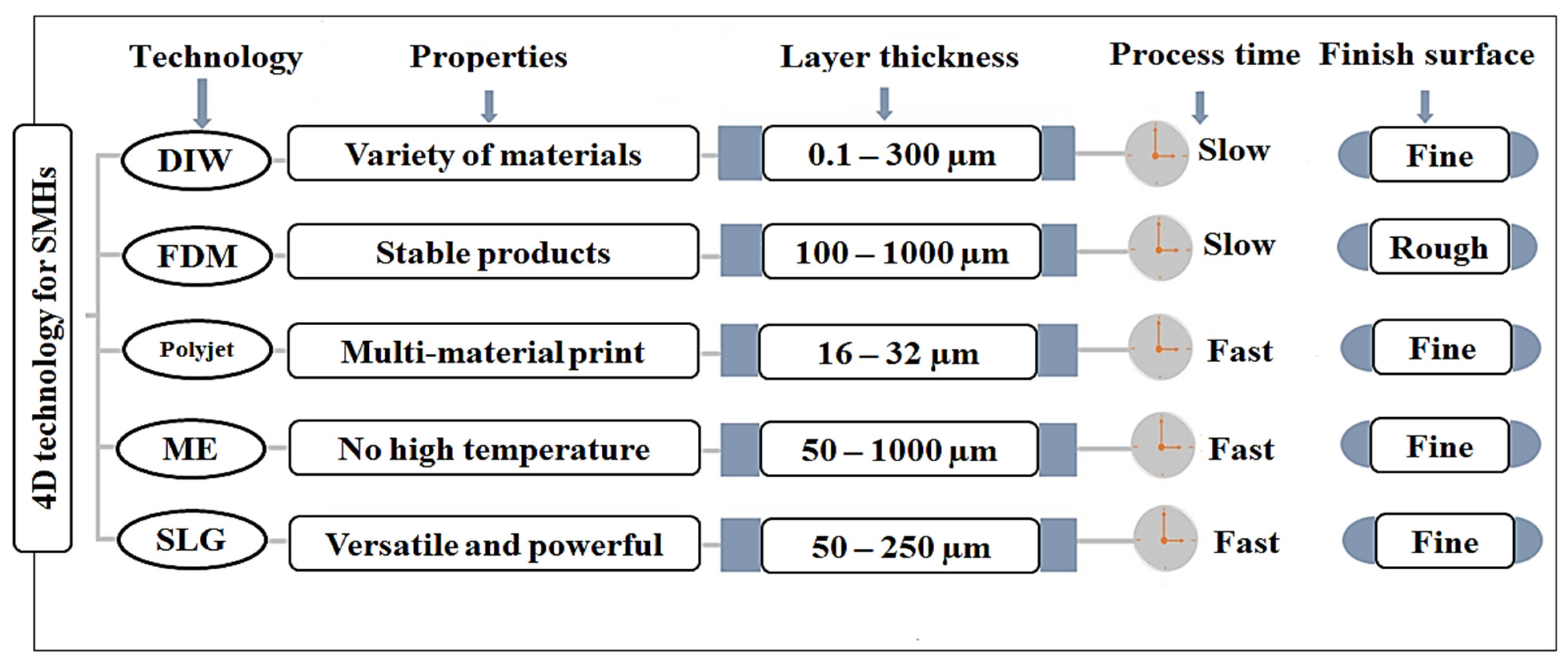
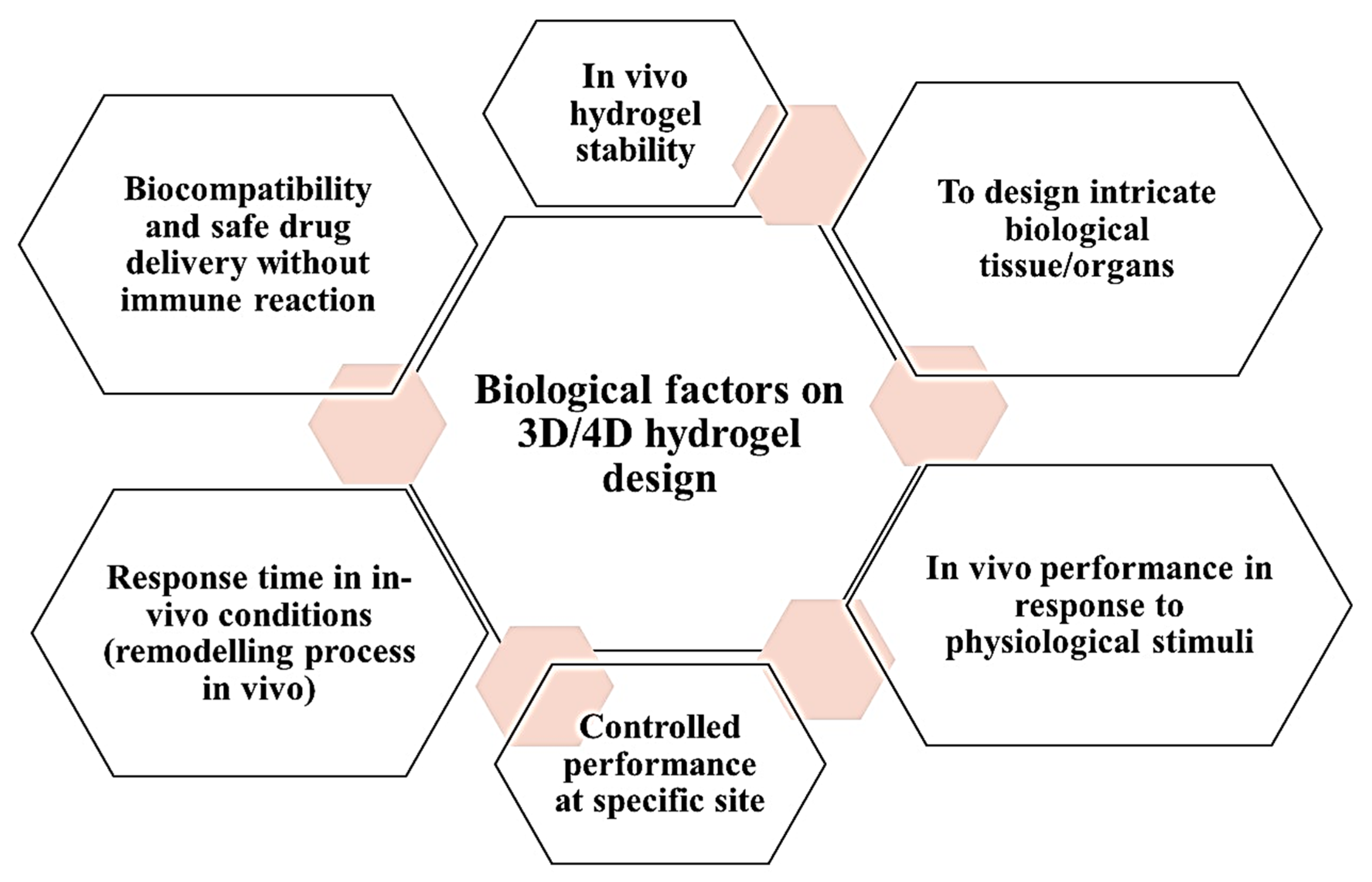
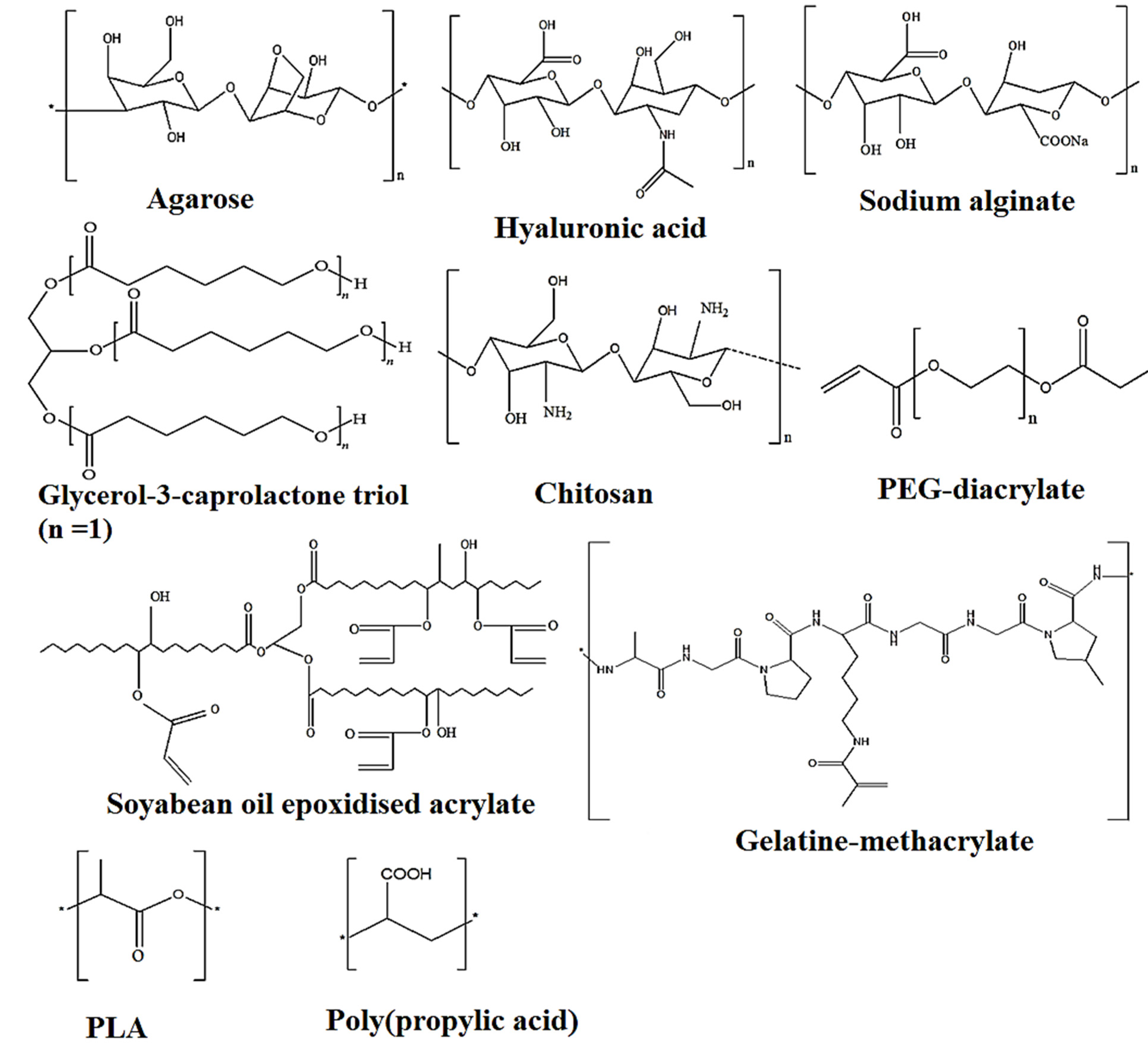
| S. No | Features | 3D Hydrogel Printing | 4D Hydrogel Printing | 4D, SMP-Based Printing |
|---|---|---|---|---|
| 1 | Fabrication process | Built in layer by layer on 2D constructs or designs from bottom to top (step-up process) | Transform 3D designs or constructs under certain external stimuli using smart materials | Transform 3D designs or constructs under certain external stimuli using shape-memory polymers |
| 2 | Materials | Biomaterial, hydrophilic material, proteins, nanomaterials, plastics | Physiological responsive biomolecules, thermoresponsive hydrophilic material, chemoresponsive proteins, stimuli responsive shape-morphing material | Physiological responsive polymers, thermoresponsive hydrophilic and lipophilic material, chemoresponsive polymers, stimuli responsive shape-morphing polymers |
| 3 | Deformation characterization | Rigid, stiff, and no flexibility | Flexible, high-swelling capability | |
| 4 | Compatibility | Incompatible | Biocompatible | Incompatible |
| 5 | Toughness | No tunable toughness | Tunable toughness | Moderate toughness |
| 6 | Water content | Low | High | Low |
| 7 | Cost | High | Low | High |
| 8 | Shape | No change over time in response to trigger stimuli in the environment | Change occurs over time in response to trigger stimuli (physical, chemical, and biological stimuli) in the surrounding environment | Change occurs over time in response to trigger stimuli in the surrounding environment |
| 9 | Programmable material | No use of advanced smart and programmable materials | Use of smart, shape-morphing, and programmable materials | Use of smart, shape-morphing polymers, and programmable polymer materials |
| 10 | Limitations | Most of these materials resulted in printed objects that were inanimate or dead, restricting their applications when time-evolving, shape transformation is needed. Low-resolution printing observed Low switching and recovery response | In practice, the development of fabrication at the microlevel with fast speed response is still critical for targeted drug delivery and bioengineering. Four dimen- sional printing of hydrogel with high complexity and multiple freedoms of shape morphing remains to be explored. Time scale is critical to control below minimum scale. High switching and recovery response | Due to low sustainability in wet environments, high rigidity, low material permeability, and probable chances of biological incompatibility due to polymer degradation over time, it cannot completely replace soft hydrophilic materials. High switching and recovery response |
| 11 | Advantages | Faster than 2D and 1D printing | Apparent transformation of 3D constructs whenever time-evolving shape transformation is required Faster printing than 3D, 2D, and 1D High-resolution printing possible using 4D hydrogels | Apparent transformation of 3D constructs whenever time-evolving shape transformation is required Faster printing than 3D, 2D, and 1D High-resolution printing possible using 4D hydrogels |
| Swelling-Induced Movement | SME of Synthetic Hydrogels | SME in Biopolymer Hydrogels | SME in Hydrogel Microstructures |
|---|---|---|---|
|
|
|
|
|
|
|
|
|
|
|
|
|
|
|
|
|
|
|
|
|
|
|
|
|
|
| |
|
| Terms | Processes | ||||||
|---|---|---|---|---|---|---|---|
| Material Extrusion | Vat Polymerization | Powder Bed Fusion | Material Jetting | Binder Jetting | Sheet Lamination | Directed Energy Deposition | |
| Technique | DIW and FDM | SLA, 2PP, and DLP | DMLS and polymer SLS | PolyJet-printing | BJ | LOM and UAM | EBM |
| Raw material | PNIPAm, PAAm, agarose, cellulose, alginate, HA, PLA, ABS, PC, PA | Typical polymers: acrylate/epoxide | Bending of unique polymers (PA-12/PEEK) | Acrylate polymers | PLA, starch, ceramics, silicon carbide | PVC polymer and paper, LIG (laser-induced graphene oxide) | Titanium, cobalt–chrome alloys, β-type Ti2448 alloy |
| Form | Solid filament and liquid ink (shear thinning behavior) | Liquid photopolymer | Blend powder | Melted liquids | Crystalline solid SiC and liquids | Solid sheets, graphene foam | Solid wire or powder |
| Advantages |
|
|
|
|
|
|
|
| Disadvantages | Poor resolution (100–150 µm). Anisotropic print High computation cost Low volume needed | Poor mechanical strength Postcuring required Supporting structure needed | Expensive Rough finished surface | Unable to recycle Postprocessing (causing damage) Low resolution Low viscosity ink | Rough surface Low viscous ink required Low temperature required | Limited materials Noxious fumes Low resolution (100–150 µm) | Poor dimensional accuracy Limited choice for materials Rough strut surface |
| Controlled parameter | Ink composition, rheology, and printing variables | - | - | - | - | - | Material property, stress |
| Largest build volume | 200 × 200 × 200 mm3 1005 × 1005 × 1005 mm3 | 250 × 250 × 250 mm3 800 × 330 × 400 mm3 | 250 × 250 × 250 mm3 1400 × 1400 × 500 mm3 | 300 × 200 × 150 mm3 1000 × 800 × 500 mm3 | 200 × 250 × 200 mm3 1000 × 600 × 500 mm3 | 300 × 200 × 150 mm3 170 × 220 × 145 mm3 | Strut thickness (460–632 µm) |
| Ref | [75,76,77] | [78,79] | [78,80] | [78] | [78,81] | [78,82,83] | [78,84,85] |
| Type of Hydrogels | Technique and Materials/Polymers | Major Findings | References |
|---|---|---|---|
|
|
| [86] |
|
| [87] | |
|
| [88] | |
|
| [89] | |
|
| [65] | |
|
|
| [90,91] |
|
| [92] | |
| PNIPAm and PHEMA (Polyhydroxyethylmethacrylate) |
| [93] | |
|
| [94] | |
|
|
| [7] |
|
| [95] | |
|
| [96] | |
|
|
| [97] |
|
| [98] | |
|
|
| [99] |
|
| [100] | |
|
|
| [101] |
|
|
| [102] |
|
| [103] |
| 3D Technique | 4D Technique |
|---|---|
| It contains the commands to print layers of material successively. | The technique adds a precise geometric code to the process as per desired shape. |
| Materials: Commonly used materials are clay, ceramics, metals, thermoplastics, printing paper, food-based materials, synthetic or natural polymers, nanomaterial, and biomaterials. | Materials: Smart shape-morphing materials/multimaterials, responsive to stimuli, and advanced materials |
| Design concept: It prints by drawing or scanning using the 3D digital object. | Design concept: It prints 3D digital object with deformation feature. |
| Transformation: 3D-printed objects cannot transform themselves over time. | Transformation: 4D-printed objects can transform themselves over time in one-way, two-way, and multiway. |
| Printer: Three-dimensional printer is required. | Printer: Four-dimensional printer is required. |
| Processing: Three-dimensional-printing technique is additive manufacturing obtained by adding rather than subtracting or shaping material by cold and hot techniques. | Processing: Four-dimensional-printing technique uses a process that produces a smart 3D construct/scaffold/object using shape-morphing materials under certain stimuli. |
| Dynamicity: The object created using a 3D printer can be static or flexible depending on the nature of materials. | Dynamicity: The smart object created using a 4D printer can undergo a real transformation (reversible) by itself under stimuli. |
| Properties: Materials have no self-assembling, self-adaptability, or self-healing properties. | Properties: Smart materials have self-assembling, self-adaptability, and self-healing properties. |
| Strength: Low cost, high efficiency process, customized model, positive market trend, high product quality | Strength: Efficient materials and process, positive market trend, multicolor material printing, smart materials, R&D on multimaterials printing |
| Weakness: Expensive equipment, production time high, quality differs using different printers, limited material selection, postprocessing may be needed, product size issue | Weakness: New technique, limited and expensive smart materials, expensive equipment and ink, relevant accuracy class, complex shapes, specialized operator needed |
| Opportunity: Customized design, recycling, smart materials, new equipment invention, develop potential materials | Opportunity: Remote operation, extreme environment, implant in medical, smart materials, 5D, and multiple materials |
| Threat: Machine compatibility, software upgradation, environmental impact, intellectual property right (IPR), market competition | Threat: Machine and software compatibility, software upgradation, public safety, IPR, market competition, environmental impact, maintenance |
| Market output: Medium | Market output: Medium-high |
| Rheology: Three-dimensional viscous hydrogel ink is nonapplicable due to rheological issue. | Rheology: Four-dimensional shear-shinning hydrogel ink is applicable for biomedical application. |
| SWOT rating for strength, weakness, opportunity, and threat is 9, 7, 8, and 7, respectively; overall rating = 31. | SWOT rating for strength, weakness, opportunity, and threat is 7, 6, 9, and 7, respectively; overall rating = 29. |
Publisher’s Note: MDPI stays neutral with regard to jurisdictional claims in published maps and institutional affiliations. |
© 2021 by the authors. Licensee MDPI, Basel, Switzerland. This article is an open access article distributed under the terms and conditions of the Creative Commons Attribution (CC BY) license (https://creativecommons.org/licenses/by/4.0/).
Share and Cite
Imam, S.S.; Hussain, A.; Altamimi, M.A.; Alshehri, S. Four-Dimensional Printing for Hydrogel: Theoretical Concept, 4D Materials, Shape-Morphing Way, and Future Perspectives. Polymers 2021, 13, 3858. https://doi.org/10.3390/polym13213858
Imam SS, Hussain A, Altamimi MA, Alshehri S. Four-Dimensional Printing for Hydrogel: Theoretical Concept, 4D Materials, Shape-Morphing Way, and Future Perspectives. Polymers. 2021; 13(21):3858. https://doi.org/10.3390/polym13213858
Chicago/Turabian StyleImam, Syed Sarim, Afzal Hussain, Mohammad A. Altamimi, and Sultan Alshehri. 2021. "Four-Dimensional Printing for Hydrogel: Theoretical Concept, 4D Materials, Shape-Morphing Way, and Future Perspectives" Polymers 13, no. 21: 3858. https://doi.org/10.3390/polym13213858
APA StyleImam, S. S., Hussain, A., Altamimi, M. A., & Alshehri, S. (2021). Four-Dimensional Printing for Hydrogel: Theoretical Concept, 4D Materials, Shape-Morphing Way, and Future Perspectives. Polymers, 13(21), 3858. https://doi.org/10.3390/polym13213858









